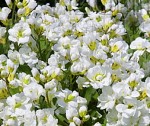 Rock cress is an evergreen herbaceous perennial native to mountainous areas from the Mediterranean to eastern Asia where it grows in well-drained soils and full sun. It is a member of the mustard family, Brassicaceae, that also includes cabbage, candytuft, and stock. The low-growing plant forms a loose mat and carries hairy, gray-green basal leaves up to two inches long. The small white flowers have four petals and are carried in loose racemes in early spring. Cut back plants hard after blooming to create more attractive plants during the summer and to enhance the following year’s bloom. Delightful choice for planting in the crevices among rocks or in walls. Rock cress prefers cool climates and grows best in zones 7 and cooler. It will bloom in warm climates but melt out in the center in the summer heat. The genus name, Arabis, may come from Arabia where some of the genera are native. The specific epithet, caucasica, refers to the Caucasus one of the places where the species is native.
Rock cress is an evergreen herbaceous perennial native to mountainous areas from the Mediterranean to eastern Asia where it grows in well-drained soils and full sun. It is a member of the mustard family, Brassicaceae, that also includes cabbage, candytuft, and stock. The low-growing plant forms a loose mat and carries hairy, gray-green basal leaves up to two inches long. The small white flowers have four petals and are carried in loose racemes in early spring. Cut back plants hard after blooming to create more attractive plants during the summer and to enhance the following year’s bloom. Delightful choice for planting in the crevices among rocks or in walls. Rock cress prefers cool climates and grows best in zones 7 and cooler. It will bloom in warm climates but melt out in the center in the summer heat. The genus name, Arabis, may come from Arabia where some of the genera are native. The specific epithet, caucasica, refers to the Caucasus one of the places where the species is native.
Type: Evergreen herbaceous perennial
Bloom: Small white flowers with four petals in loose racemes in early spring
Size: 8-10” H x 18” W
Light: Full sun
Soil: Average, dry to medium moist, well-drained; tolerates drought and infertile soil.
Hardiness: Zones 4-8
Care: Cut back hard after flowering
Pests and Diseases: Susceptible to root rot, downy mildew, gray mold, white rust , aphids
Propagation: Division, cuttings, seeds
Companion plants: Alyssum, basket of gold, coral bells, creeping pholox, hens and chickens, pasque flower
Outstanding Selections:
Var. flore=plena (more persistent flowers)
‘Rosabella’ (fading rose colored flowers )
‘Snowball (White flowers on 4-6” high plants)
‘Snow Cap’ (Large flowers)
var. Variegata (Yellow-white striped leaves)